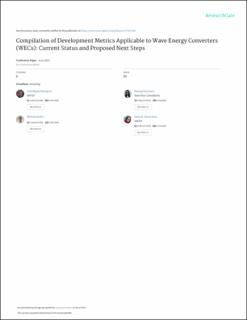| dc.contributor.author | Dos Santos Sousa Rodrigues, José Miguel | |
| dc.contributor.author | Langhelle, Nina Kristin | |
| dc.contributor.author | Rølvåg, Terje | |
| dc.contributor.author | Cruz, João | |
| dc.contributor.author | Atcheson Cruz, Mairead | |
| dc.contributor.author | Martini, Michele | |
| dc.contributor.author | Garcia Rosa, Paula Bastos | |
| dc.contributor.author | Kamidelivand, Mitra | |
| dc.contributor.author | Alessandri, Giacomo | |
| dc.contributor.author | Gallorini, Federico | |
| dc.date.accessioned | 2024-04-04T12:58:22Z | |
| dc.date.available | 2024-04-04T12:58:22Z | |
| dc.date.created | 2024-04-03T09:13:02Z | |
| dc.date.issued | 2023 | |
| dc.identifier.citation | Proceedings of the Thirty-third (2023) International Ocean and Polar Engineering Conference, Ottawa, Canada, June 19-23, 2023 - ISOPE 2023 | en_US |
| dc.identifier.isbn | 978-1-880653-80-7 | |
| dc.identifier.issn | 1098-6189 | |
| dc.identifier.uri | https://hdl.handle.net/11250/3124893 | |
| dc.description.abstract | As for any novel technology, the need to consider, identify and formulate performance requirements and related assessment criteria has been an important subject in the development of Wave Energy Converters (WECs). These allow the characterisation of each technology through techno-economic indicators, which in turn allow comparisons between different technologies, and an assessment of alternative solutions throughout all the development stages. Such assessment is ideally carried out through the application of metrics, which should comply with several attributes, such as being objective, quantitative, specific, measurable, repeatable, and independent. In the present work, more than 50 metrics to monitor the development of WECs are compiled, explained, and discussed. These metrics are divided in the following evaluation areas: 1) Performance; 2) Reliability; 3) Survivability; 4) Techno-economics. In addition, the important evaluation area of Environmental Impact is briefly discussed concerning the need for common metrics. The compilation summarised in this paper and its discussion aim to provide a practical reference source concerning metrics for WEC development, which is currently unavailable in the published literature in terms of broadness and condensed presentation. Such compilation includes multiple formulations from the wave energy sector and other relatable industries (e.g. wind energy) that are typically diluted among specialist literature, standards, guidelines and recommendations, scientific papers, and project reports. The paper is concluded with a reflection of any salient gaps that are not addressed by current metrics, in a context of accelerating the development of WEC technologies. © 2023 by the International Society of Offshore and Polar Engineers (ISOPE). | en_US |
| dc.description.abstract | Compilation of Development Metrics Applicable to Wave Energy Converters (WECs): Current Status and Proposed Next Steps | en_US |
| dc.language.iso | eng | en_US |
| dc.publisher | ISOPE | en_US |
| dc.relation.ispartof | Proceedings of the Thirty-third (2023) International Ocean and Polar Engineering Conference, Ottawa, Canada, June 19-23, 2023 - ISOPE 2023 | |
| dc.relation.ispartofseries | ISOPE - International Offshore and Polar Engineering Conference. Proceedings;33 | |
| dc.title | Compilation of Development Metrics Applicable to Wave Energy Converters (WECs): Current Status and Proposed Next Steps | en_US |
| dc.title.alternative | Compilation of Development Metrics Applicable to Wave Energy Converters (WECs): Current Status and Proposed Next Steps | en_US |
| dc.type | Chapter | en_US |
| dc.type | Peer reviewed | en_US |
| dc.description.version | publishedVersion | en_US |
| dc.source.pagenumber | 749-758 | en_US |
| dc.identifier.cristin | 2258405 | |
| dc.relation.project | EC/H2020/101007071 | en_US |
| dc.source.articlenumber | ISOPE-I-23-108 | en_US |
| cristin.ispublished | true | |
| cristin.fulltext | original | |
| cristin.qualitycode | 1 | |
